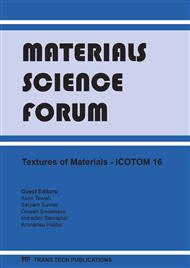p.718
p.722
p.726
p.730
p.734
p.738
p.742
p.746
p.750
Modeling the Magnetic Properties of Non-Oriented Electrical Steels Based on Microstructural Parameters
Abstract:
Magnetic properties of electrical steels such as magnetization behavior and electrical losses are mainly related to chemical composition, crystallographic orientation and microstructure. By now, several models have been proposed to empirically correlate magnetic properties and affecting parameters. A quantitative model based on physical understanding of the interaction between the magnetic field variables (e.g. domain structure) and local microstructural variables (e.g. grain orientation and misorientation, grain boundary plane inclination) is still missing. To obtain a better understanding of the interaction between grain boundaries and domain walls, the magnitude of free pole density at grain boundaries was taken into account. Experimental results from 3-dimentional EBSD experiments were employed to measure the grain boundary orientation for several samples with different chemical composition and grain size. The free pole density was calculated using the relative misorientation between adjacent grains, and was included in a model together with grain size, magnetocrystalline anisotropy energy and silicon equivalent. By comparison with the experimental results of the magnetic induction measured at low, medium and high magnetic fields, is shown that the magnetization behavior can be more accurately predicted when the above mentioned phenomena are taken into account.
Info:
Periodical:
Pages:
734-737
Citation:
Online since:
December 2011
Authors:
Price:
Сopyright:
© 2012 Trans Tech Publications Ltd. All Rights Reserved
Share:
Citation:


